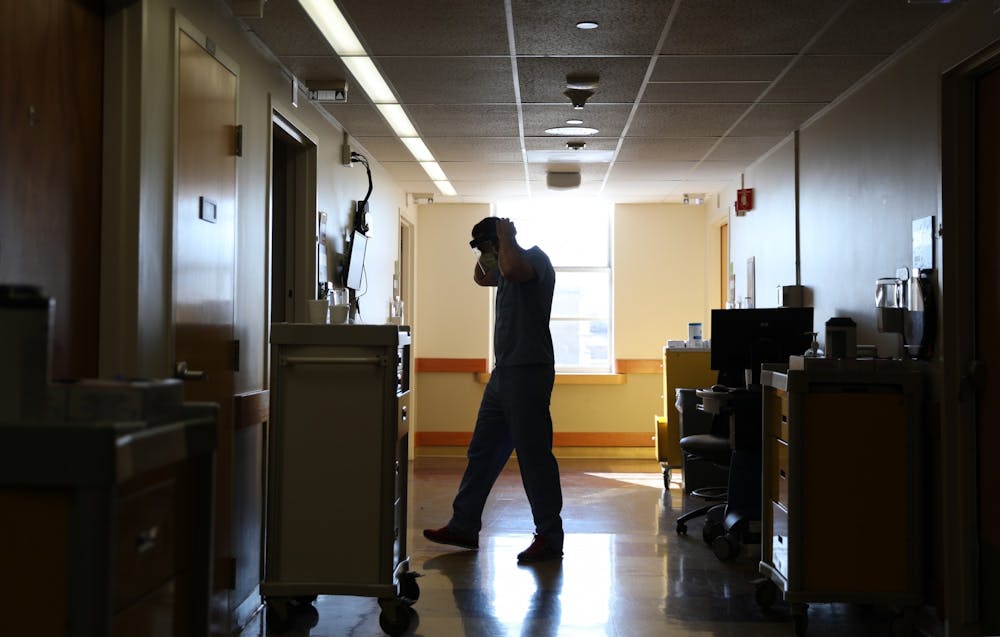It was Thanksgiving 2020, and Kari Malloy was working as a charge nurse at Indiana University Health Methodist Hospital when she first noticed a tickling feeling in her throat. She turned to her secretary.
“Gosh, my throat has just been dry all day,” she said. “I’m sure it’s just allergies.”
Everybody in the room looked at each other and laughed. Eight months into the COVID-19 pandemic, every one of them knew it wasn’t just allergies.
After getting a test, Malloy found she was positive for COVID-19.
Eventually, Malloy said she was “the sickest [she’d] ever felt in [her] entire life.”
Aside from the initial scratchy throat, Malloy was in physical pain from her muscle aches. She experienced a fever and chills while losing her sense of taste and smell.
Then, she transmitted it to her 20-year-old daughter, Ashlynn.
“I felt terrible because when I got sick, I got my daughter sick, and that was the last thing I wanted to do,” Malloy said. “I have such a strict regimen on making sure nothing I wear from work goes home. So for me, I felt like I gave that to her, and it was just heartbreaking.”
Even now, Malloy’s sense of smell comes and goes, and her sense of taste isn’t the same as it was before. She still changes her clothes in the garage before she enters her house and wipes her car down every day when she gets home. Malloy, who has been a nurse for 12 years, has been working 12-hour shifts during the pandemic.
‘Variant of concern’
The staff at Methodist Hospital in Indianapolis describe a collective feeling of burnout. Warren Gavin, hospitalist at Methodist, said a recent spike in COVID-19 case numbers has left hospital staff feeling as exhausted as ever.
“I think fatigue is one of the biggest things that everybody’s been feeling,” Gavin said. “There’s a lot of question — 'Are hospital systems truly overwhelmed?' You hear that. And, yes — yes they are.”

The Centers for Disease Control and Prevention (CDC) first identified a case of the COVID-19 omicron variant Nov. 24, 2021. Two days later, the World Health Organization (WHO) classified it as a “variant of concern.” Five days after that, the variant’s first case was identified in the United States.
According to the CDC, the omicron variant spreads more easily than both the original COVID-19 variant and the delta variant. Although the CDC states the current vaccines administered in the U.S. are effective against the variant, it also reports breakthrough infections in those who are fully vaccinated are more likely to occur.
Regardless, Gavin has found the majority of cases he sees at Methodist, on what he calls the “COVID floor,” are from those who remain unvaccinated.
In early January, there were 166 patients between Methodist and Indiana University Health University Hospital with COVID-19. Of those patients, Gavin said, only about 4 percent were fully vaccinated with a booster shot. About 25 percent had their full vaccination series but no booster. About 70 percent were entirely unvaccinated.
On Jan. 27, a patient ready to leave Methodist after being kept for COVID-19 complications decided they wanted to receive the vaccine. When Philip King, pharmacist at Methodist, readied the shot and brought it to a nurse — a process that took no more than 10 minutes — the nurse informed him the patient no longer wanted it.
“It’s frustrating because we have tools out there to mitigate this, yet you’re still seeing large percentages of unvaccinated populations showing up in the hospital,” King said.
On the other hand, Malloy recalled treating a patient who, after having been in the intensive care unit for about 20-25 days, chose to receive the vaccine after finally being discharged.
According to the CDC, as of Feb. 9, about 53.5 percent of Indiana’s population is fully vaccinated while only about 43.1 percent of that population have received their booster shots. Nationally, those numbers are 64.2 percent and 42.4 percent, respectively.
To Gavin, the strikingly low percentage of patients he treats who have received their booster shots proves they are effective in preventing severe bouts of COVID-19.
“What that 25 percent tells me is that there’s still … a good proportion of patients that are vaccinated but didn’t get boosted, that can still get sick,” Gavin said. “It’s evidence to me that the booster does mean something, and it does help.”
‘Fear and uncertainty’
When COVID-19 was first declared a pandemic by the WHO March 11, 2020, King said there was almost a common “fear-of-the-unknown” feeling for those at the Methodist Hospital. By virtue of being a novel coronavirus, the disease itself was unknown. Doctors, as well as the public, were forced to figure out the details of the situation as it played out.

Philip King poses for a photo in an employee lounge Feb. 8 at Indiana University Health Methodist Hospital in Indianapolis. King works as a pharmacist at the hospital, and has lost a grandfather, grandmother and uncle to COVID-19. Rylan Capper, DN
“Initially, we were afraid to even look at a doorknob and touch it because you thought that it had COVID on it,” King said. “We didn’t know or have any of the tools to effectively treat patients in the beginning, so there were a lot of patients who were in the ICUs. We were running short on equipment and our PPE and everything like that.”
However, while the coronavirus is no longer as novel as it was before, King said the pandemic has still affected aspects of his job he once took for granted. Supply chain issues have led to drug shortages at hospitals like Methodist, and these issues can be directly related back to the pandemic itself. Labor shortages, factory closings, interruptions in global trade and an increase in demand have resulted from pandemic-related shutdowns and led to products across the market being in much lower supply.
King explained this shortage with an analogy of a patient who is in need of painkillers. If the best option for this patient is unavailable due to a lack of staff producing the medicine, the pharmacist naturally turns to the next best option. The more pharmacists who do this, the more quickly that next-best supplier runs out of product. Then, the process repeats for the third-best and, eventually, fourth-best options. Each time, the patient is left with a less ideal medication.
King also said these shortages are made worse when other hospitals hoard valuable medications by overbuying them whenever another shortage is near. Therefore, smaller hospitals that don’t have the same buying power as larger hospitals are unable to receive the best drugs for their patients.
Nevertheless, despite the complications and unpredictability of COVID-19, Gavin said the initial “fear and uncertainty” he felt, while never having gone away, has subsided.
“That initial fear and that initial uncertainty … has decreased markedly. As we have experience with this virus, I think the uncertainty goes away a little bit,” Gavin said. “As the studies come out, we understand, ‘Hey, these medications may be effective here.’ And that’s obviously still holding, but that uncertainty was lessened due to our experience with it — and the fear was lessened.”
Gavin credited this mostly to the vaccine rollout, which gave him and his colleagues a form of effective protection against the virus.
‘Science works’
As a pharmacist, King said he has taken the pandemic seriously from the beginning. He’s seen what the virus has done to vulnerable patients like his grandfather, grandmother and uncle, all of whom he lost to COVID-19.
“It’s personal, at this point,” King said. “And it doesn’t have to go on for this long, in my opinion.”

An empty bed sits in a hospital unit Feb. 8 at Indiana University Health Methodist Hospital. Over 900,000 people have died of COVID-19 in the U.S. since the first case was reported in January 2020. Rylan Capper, DN
Malloy, in part, attributed the length of the pandemic to the politicization it experienced near its start.
While an advocate for the vaccine herself, Malloy said she has close relatives who are still hesitant to receive theirs. They’ve accused her of peddling an ineffective drug, telling her the only reason she believes in it “is because [she sees] it every day.” The “us-versus-them” mentality she said she’s seen so many people develop has caused her to delete each of her social media profiles.
Even so, Malloy said the hospital that’s been the source of her exhaustion has also been a source of comfort. Her colleagues, who can relate to her experiences more than anybody outside of Methodist, have been an outlet for her struggles. Spending nearly every day with each other, they’ve developed close relationships and have begun to lean on each other.
Another solace, she said, has been the family she goes home to every day. Being a mother and a nurse, Malloy said she’s made sure her children are well-educated: they’ve known the basics of the virus since the pandemic’s beginning, she’s taught them sexual education since they were young and they regularly perform family science experiments. Her daughter is studying biochemistry at Manchester University. Her 11-year-old son dreams of working for NASA.
After Malloy took her son to receive the vaccine, he attempted to tell everybody in his grade to also get it because “science works.” Proud of his encouragement, when he got home, he told his mother what he told all the other children.
“Yes, you’re right, buddy,” she said, laughing. “Science works.”
Contact Joey Sills with comments at joey.sills@bsu.edu or on Twitter @sillsjoey.





